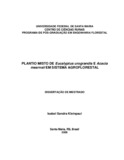| dc.creator | Kleinpaul, Isabel Sandra | |
| dc.date.accessioned | 2008-12-15 | |
| dc.date.available | 2008-12-15 | |
| dc.date.issued | 2008-07-17 | |
| dc.identifier.citation | KLEINPAUL, Isabel Sandra. Eucalyptus urograndis AND Acacia mearnsii MIXED STANDS IN AN AGROFORESTRY SYSTEM. 2008. 88 f. Dissertação (Mestrado em Recursos Florestais e Engenharia Florestal) - Universidade Federal de Santa Maria, Santa Maria, 2008. | por |
| dc.identifier.uri | http://repositorio.ufsm.br/handle/1/8637 | |
| dc.description.abstract | This study had as objective to evaluate a mixed stand of Eucalyptus urograndis and Acacia mearnsii in an agroforestry system with corn (Zea mays L.). The study was
conducted in Bagé county, in a partnership with VCP (Votorantim Celulose e Papel) company. The study was installed in December 2006, with five different treatments
(T1- 100% eucalyptus; T2- 100% black-wattle; T3- 50% eucalyptus+ 50% blackwattle; T4- 75% eucalyptus + 25% black-wattle and T5- 25% eucalyptus + 75% black-wattle), with 4 m x 1,5 m planting space. Three lines of corn were planted, between the eucalyptus and/or black-wattle lines. 10 months after the installation, a inventory was done, where all the stem diameters and the total height were
measures, for further volume determination. At the same time the biomasses from forest species were quantified, they were separated in fractions (leave, branch and
stem). Corn biomass was collected in the end of the cycle and separated in fractions (leave, straw, grain, corn cob and stem). Homogeneous eucalyptus and black-wattle
stands did not differ in height and stem diameter related to mixed stand. Black-wattle
cylindrical volume, both in homogeneous and mixed stand was higher for eucalyptus,
because showed a highest initial growth. In mixed stands, the treatment T5
(25E:75A) showed a highest biomass accumulation, being 35,1% in the leaves,
25,8% in branches and 39,1% in stem. Biomass accumulation for each fraction, had
the following order, for T1 and T3: stem>branch>leaf and, for T2, T3, T4 and T5:
stem>leaf>branch. The highest levels of nutrients in trees biomass, are in the leaves,
followed by branches and stem. Black-wattle in homogeneous stands, showed
highest nutrients accumulation, because it had the highest amount of total biomass.
The highest percentage of corn grains was observed in T4 (75E:25A), with 38,4%
from the total biomass of this treatment. Grains showed the highest amounts for N, P,
Mg, B and Zn. In treatment T4 (75E:25A), corn exported more nutrients, because
showed the highest grain production. | eng |
| dc.format | application/pdf | por |
| dc.language | por | por |
| dc.publisher | Universidade Federal de Santa Maria | por |
| dc.rights | Acesso Aberto | por |
| dc.subject | Plantio misto | por |
| dc.subject | Sistema agroflorestal | por |
| dc.subject | Biomassa | por |
| dc.subject | Nutrientes | por |
| dc.subject | Mixed planting | eng |
| dc.subject | Agroforestry system | eng |
| dc.subject | Biomass, nutrients | eng |
| dc.title | Plantio misto de Eucalyptus urograndis e Acacia mearnsii em um sistema agroflorestal | por |
| dc.title.alternative | Eucalyptus urograndis and Acacia mearnsii mixed stands in an agroforestry system | eng |
| dc.type | Dissertação | por |
| dc.description.resumo | O objetivo deste estudo foi avaliar um plantio misto de Eucalyptus urograndis e Acacia mearnsii em sistema agroflorestal com milho (Zea mays L.). O estudo foi
realizado no município de Bagé, em parceria com a VCP (Votorantim Celulose e Papel). A implantação da pesquisa foi em dezembro de 2006, com cinco tratamentos
diferentes (T1- 100% eucalipto; T2- 100% acácia-negra; T3- 50% eucalipto + 50% acácia-negra; T4- 75% eucalipto + 25% acácia-negra e T5- 25% eucalipto + 75%
acácia-negra), com espaçamento de 4 m x 1,5 m. Foram plantadas 3 linhas de milho, entre as fileiras de eucalipto e/ou acácia-negra. Aos 10 meses de plantio, foi realizado um inventário na área, sendo medidos, o diâmetro do colo e a altura total, para posterior determinação do volume. Na mesma ocasião foi quantificada a biomassa das espécies florestais, que foram separadas por frações (folha, galho e
tronco). A biomassa do milho foi coletada no final do ciclo e separada por frações (folha, palha, grão, sabugo e colmo). O plantio homogêneo de eucalipto e acácianegra, não diferiu em altura e diâmetro do colo em relação ao plantio misto. O
volume cilíndrico da acácia-negra, tanto em plantio homogêneo como misto, foi maior que para o eucalipto, pois apresentou maior crescimento inicial. Em plantio misto o tratamento T5 (25E:75A) apresentou o maior acúmulo de
biomassa, sendo 35,1% nas folhas, 25,8% nos galhos e 39,1% no tronco. O acúmulo de biomassa para cada fração, teve a seguinte ordem, para T1 e T3: tronco>galho>folha e, para T2, T4 e T5: tronco>folha>galho. Os maiores teores de nutrientes da biomassa das árvores, encontram-se nas folhas, seguidas de galhos e tronco. A acácia-negra em plantio homogêneo, apresentou maior acúmulo de nutrientes, pois teve maior quantidade de biomassa total. A maior porcentagem de grãos de milho, foi observada no T4(75E:25A), com 38,4% da
biomassa total deste tratamento. Os grãos, apresentaram os maiores teores para N, P, Mg, B e Zn. No tratamento T4(75E:25A), a cultura do milho exportou mais nutrientes, por apresentar maior produção de grãos. | por |
| dc.contributor.advisor1 | Schumacher, Mauro Valdir | |
| dc.contributor.advisor1Lattes | http://buscatextual.cnpq.br/buscatextual/visualizacv.do?id=K4784985T4 | por |
| dc.contributor.referee1 | Eltz, Flavio Luiz Foletto | |
| dc.contributor.referee1Lattes | http://buscatextual.cnpq.br/buscatextual/visualizacv.do?id=K4783385Z3 | por |
| dc.contributor.referee2 | Muller, Ivanor | |
| dc.contributor.referee2Lattes | http://buscatextual.cnpq.br/buscatextual/visualizacv.do?id=K4718818H8 | por |
| dc.creator.Lattes | http://buscatextual.cnpq.br/buscatextual/visualizacv.do?id=K4711781E5 | por |
| dc.publisher.country | BR | por |
| dc.publisher.department | Recursos Florestais e Engenharia Florestal | por |
| dc.publisher.initials | UFSM | por |
| dc.publisher.program | Programa de Pós-Graduação em Engenharia Florestal | por |
| dc.subject.cnpq | CNPQ::CIENCIAS AGRARIAS::RECURSOS FLORESTAIS E ENGENHARIA FLORESTAL | por |


